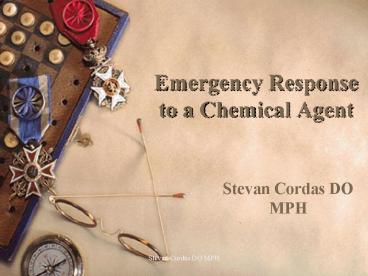Emergency Response to a Chemical Agent - PowerPoint PPT Presentation
1 / 15
Title:
Emergency Response to a Chemical Agent
Description:
Break out personal protective equipment, antidotes and decon supplies. ... Is a vesicant likely? Did the burns start immediately after exposure? ... – PowerPoint PPT presentation
Number of Views:59
Avg rating:3.0/5.0
Title: Emergency Response to a Chemical Agent
1
Emergency Response to a Chemical Agent
- Stevan Cordas DO MPH
2
Initial Steps
- If pre-warned use the following preparations
- Try to identify what the chemical agent is.
- Break out personal protective equipment,
antidotes and decon supplies. - If a chemical agent is likely or certain, don
personal protective equipment. - Clear and secure all areas that may be or have
been contaminated. Establish a hot zone.
3
Step 2
- Set up a hot line and call in a coordinator.
- Prepare to secure the hospital entrances and
grounds. - Notify local health department and civil
authorities. Have the police, FBI, army and local
health department phone numbers on hand for
emergency use.
4
Step 3
- When victim arrives.
- While wearing protective gear, try to determine
if a chemical hazard is present and applies to
that victim. Examine for miosis, vital signs,
etc. Are any of the EMT sick? Get and use m8
paper to help identify chemical. - Ask if any odors were noted. This is seen with
mustard, phosgene, lewisite, chlorine.
5
Step 4
- It is better to work with a trained team. If any
liquid is present or M8 paper is positive remove
clothes and decontaminate with soap and water
before you bring the patient into the building.
Properly dispose of garments. Dont forget to
decontaminate his hair. - Attend to breathing problems at the same time.
Establish airway. Artificial respiration if not
breathing.
6
Signs of Nerve Agent
- Pinpoint pupils.
- Difficulty breathing.
- Sweating.
- Copious secretions.
- Muscle fasciculations.
- Nausea.
- Vomiting.
- Diarrhea.
- Sensorial changes
- Coma
- Convulsions
7
Nerve Gas Protocol
- If respiratory distress
- Intubate and ventilate.
- Give atropine 6 mg IM or IV for adults.
- Peds dose is 15 to 25 ?g/kg.
- Give 600 to 1000 mg of 2-PAM Cl IM or slowly IV.
Peds dose is 15 mg/kg. - Attend to secretions. Observe carefully.
8
Nerve Gas Protocol Continued
- Repeat atropine 2 mg (adult) every 30 to one hour
as needed. You will not change miosis. Look for
improvement in respiration and control of
secretions. Peds 15 ?g/kg. - Repeat the 2-PAM Cl every hour for a total of
three doses. Give 1gm IV over a 20 minute period.
9
Nerve Gas Protocol Continued.
- If seizures give diazepam 10 mg slowly IV.
- Warn pharmacy that large amounts of atropine and
2-PAM may be necessary. - Provide additional supportive care as required.
Monitor for hypoxia, cardiac arrhythmias.
10
Blister Gas
- Is a vesicant likely?
- Did the burns start immediately after exposure?
- Did you exclude thermal burns?
- If immediate think of lewisite(l). If delayed
onset think of mustard (HD). - Mustard smells like garlic or onions, lewisite
like geraniums.
11
Blister Gas Effects
- With mustard there are systemic effects. They may
be reduced to some extent with sodium thiosulfate
if given within 20 minutes of exposure but the
vesicles do not start for 2 to 24 hours. - Aphonia, temporary blindness, secondary
respiratory or cutaneous infection is common as
is fever, nausea and depression.
12
Blister Gas Protocol
- Decontaminate with 110 bleach if available. Soap
and water OK if not. Use saline or water in eyes. - If problems breathing, consider a tracheotomy
early.
13
Blister Gas Protocol
- If large areas of burns, establish an IV line but
do not push fluids. - Drain vesicles. They do not contain
mustard.Unroof larger vesicles and irrigate with
an antibiotic solution. - MS or other analgesics. Treat supportively.
- Cool mist for tracheitis or laryngitis.
14
Cyanide Protocol
- Speed is essential.
- First bind the cyanide with hydroxycobalamine,
amyl nitrate or sodium nitrate. Do not use amyl
nitrate with oxygen as an explosion may occur. - May need to provide artificial respiration,
intubation and O2 therapy early on.
15
Cyanide Protocol
- Sodium nitrate is given 10 cc of a 3 solution
(300 mg) IV over a 3 minute period. - If using hydroxy B12, use 4 Gms IV slowly over 3
minutes. Dont use IM. - Follow either of these with sodium thiosulfate.
Give 50cc of the 50 solution (12.5 gm) IV over
10 minutes. - Eli Lilly cyanide kit.





![About Nuclear, biological, and chemical [NBC] Attack? PowerPoint PPT Presentation](https://s3.amazonaws.com/images.powershow.com/10003306.th0.jpg?_=20240224121)

























